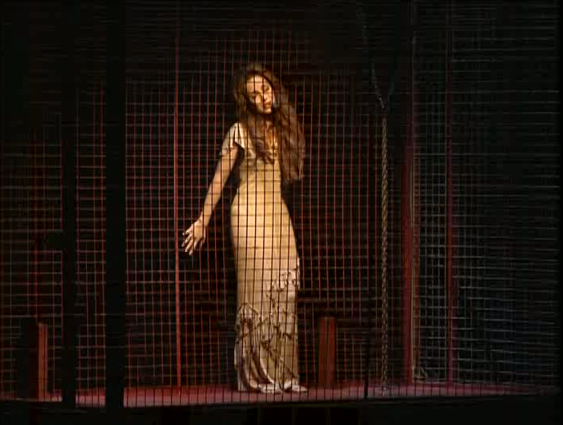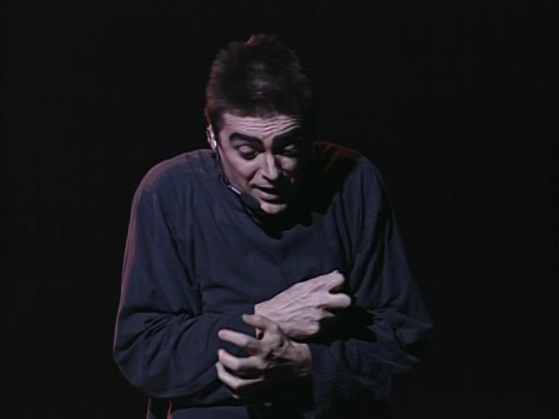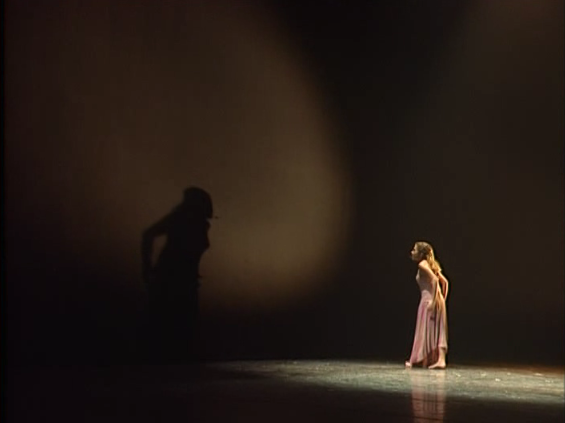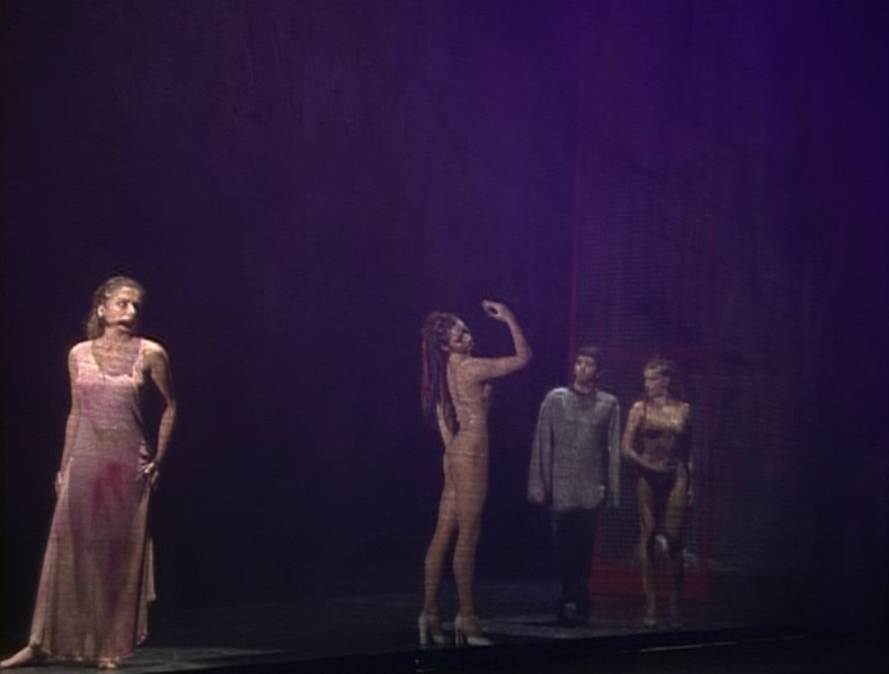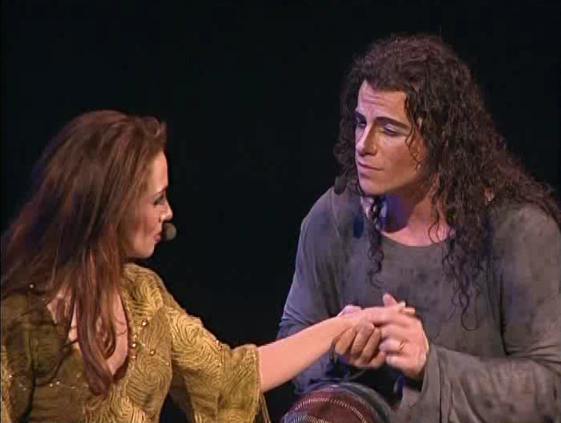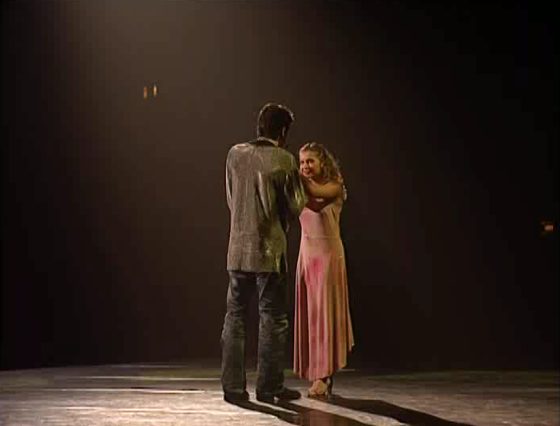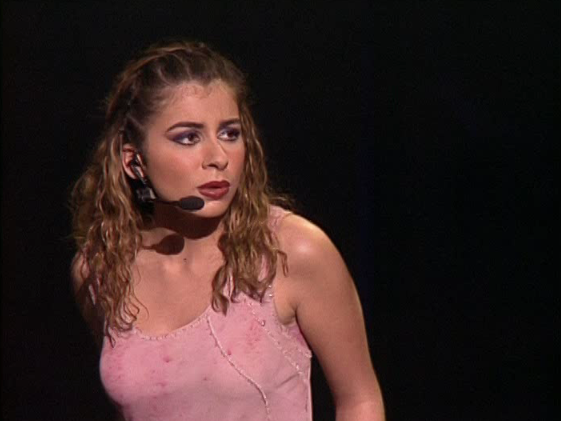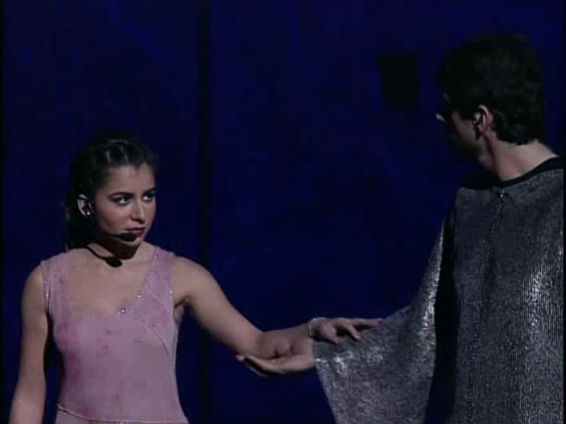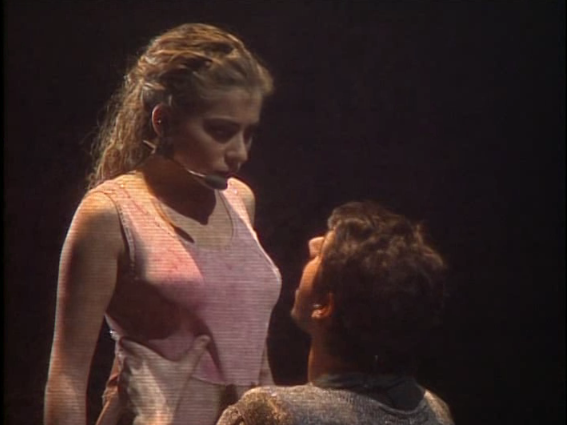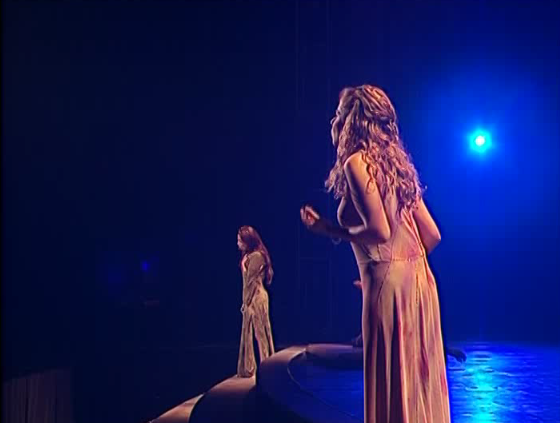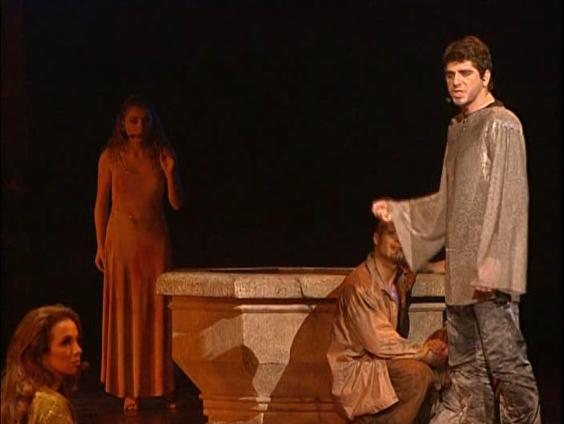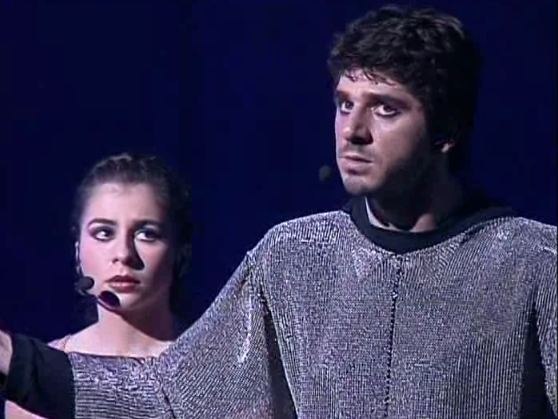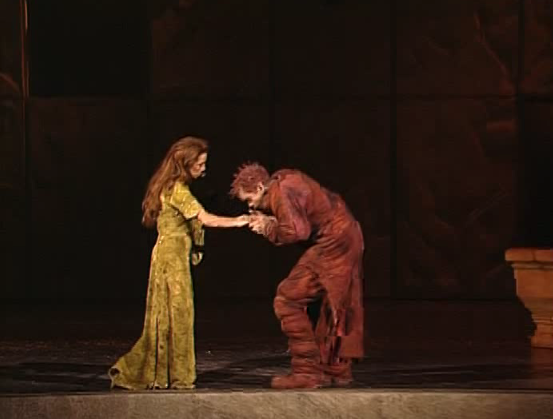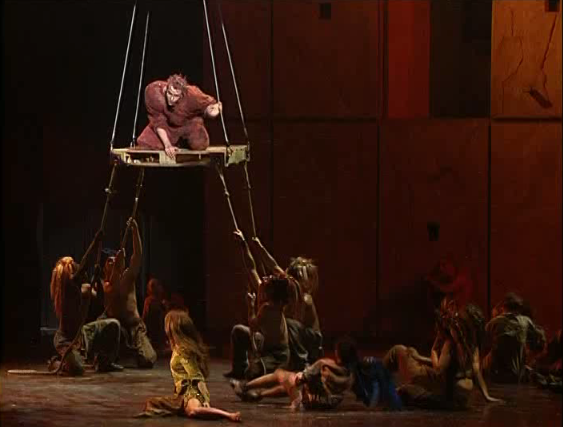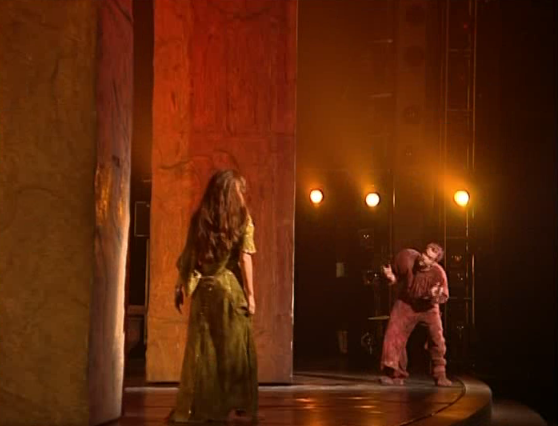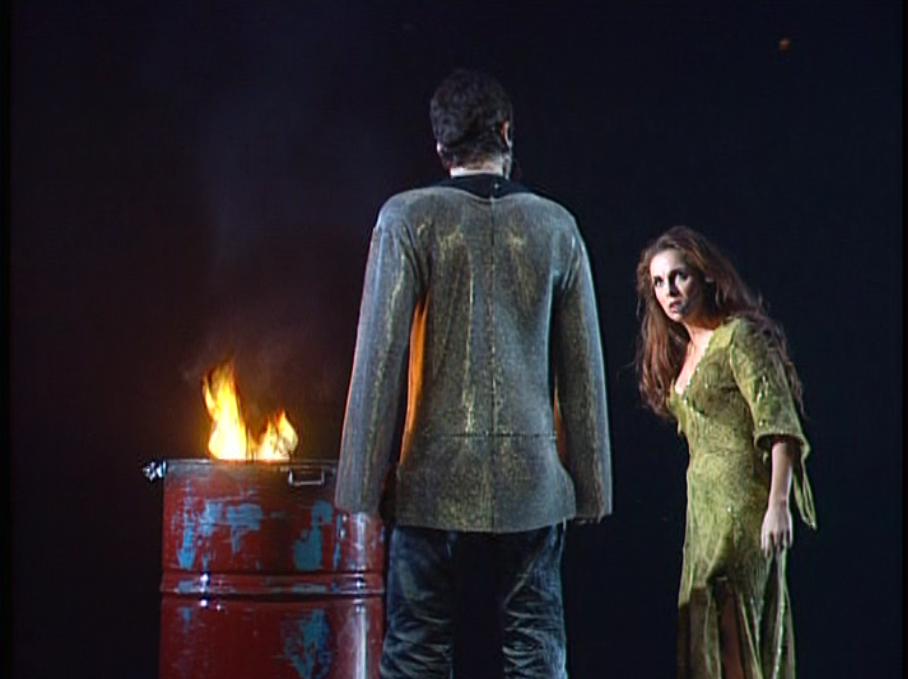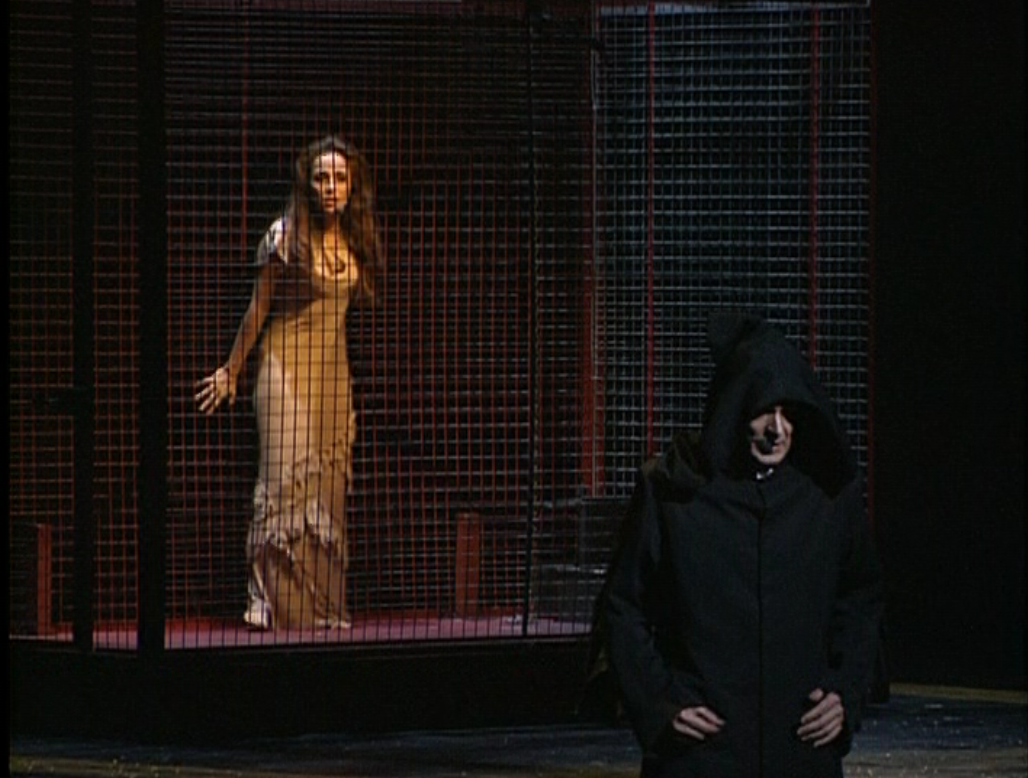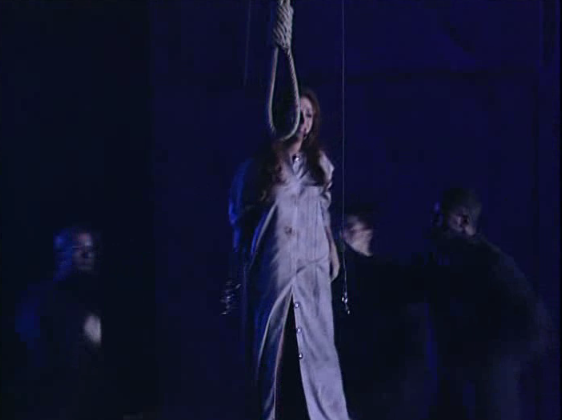In most other versions the order of these songs is a little different. It goes Être Prétre et aimer une Femme, Phoebus, then Je te reviens vers toi and finally La Monture. Both orders make a level of sense but I prefer the original, it just always seemed odd to me that Frollo would sings about loving a woman right after he tortured her, but the order made sense to someone.
Phoebus
Phoebus is Esmeralda’s plea to the aforementioned. She bittersweetly asks him to save her and gives some exposition about how the man in black stabbed him. She then begs him to at least remember her.
It’s a pretty yet simple song that has a lovely melody that has wave like quality.
Être Prétre et aimer une Femme (To be a Priest and to love a woman)
Être Prétre et aimer une Femme lifts a lots of its lines from Frollo’s confession to Esmeralda in the jail, so basically I love this song and what is so great about Notre Dame de Paris
is that we get two instances of the jail scene, so yay.
This song has a lot of power and moving lines. Frollo is a preist and therefore not free to love a woman but he can’t help it because as he stifled his emotions, he has no power to fight them when they are super strong.
The songs also makes it seem that Frollo’s “love” for Esmeralda is not just lust-based, he seems to love is some weird twisted way. This is in constast to other versions and even some versions of Notre Dame de Paris and it really could just come down to Daniel Lavoie’s acting.
The melody is also great. It has a great off-kilter tone that is still pretty which suits Frollo.
La Monture (The Mounting)
La Monture is Fleur-de-Lys’ big number. It’s the songs that really drives home her personality which all the versions is the biggest is this musical. Pending on what version of the musical you are watching this songs is vastly differnet because of the order of song and the staging.
In the original, Fleur-de-Lys sings this song to herself/shadow. This looks cool on the DVD but perhaps to an audience it doesn’t have the same effect so they changed the staging. What is nice about her singing to herself is it makes her look desperate and at her limits and it also makes her asking for Esmeralda’s death seem like it has a pathos because she at the end of her rope and can’r cope with Phoebus anymore. There is no doubt that she means it, she wants Esmeralda dead as there is a just spitefulness in her voice.
The other staging has Fleur-de-Lys singing directly to Phoebus after he sings Je te reviens vers toi. She singings in less a desperate, spiteful way and more in a sexual way. Basically she doesn’t believe Phoebus‘ song even though Phoebus says in his song that Esmeralda will die (at least in the French and English version), though in English he asks Fleur-de-Lys what me must to to get back with her. This staging make Fleur-de-Lys more calculating, cruel and cold. She is more in control of herself and Phoebus and she uses her leverage to get what she wants, the competition dealt away with.
I think it comes down to preference. One staging gives Fleur-de-Lys a little more sadness as she in not as in control of herself or her emotions and the other gives her power and control but she uses it to ensure someone’s death.
Now as far as the song its self goes, because I almost forgot to discuss the song, silly me. It’s great. Like some other songs at this point in the show it has that off-kilter prettiness and Fleur-de-Lys‘ sweet voice is a great contrast to the horrors that she is singings. It’s is Fleur-de-Lys‘ best song in the show, which isn’t REALLY saying that much since it like three but it’s great non the less.
Je te reviens vers toi (I return to you)
I REALLY hate this song. It’s mean. Phoebus sings about how he is returning to Fleur-de-Lys and he is all better now. Since it’s clear that Phoebus is lying it probabdly why they switch the songs around but Esmeralda is going to die and yet Fleur-de-Lys is like, “ok makes she does,” not sure why that would have been hard for Phoebus, but even about the order changes.
I dunno this song just seemed mean but it does showoff Phoebus‘ singing and has a nice powerful beat. It’s the subject matter that is detestable and so is Phoebus.
Fun Fact – Patrick Fiori once made the mistake of saying “From the Deeps of you, it’s me I still love” instead of ‘From the Deeps of me it’s you I still love,” pardon my bad translation I only took a year of French but it’s a silly mistake that I could see a Phoebus saying.
Get the whole GLORIOUS ALBUM HERE
Can you guess the theme of these songs?
Le Mot Phoebus (The word Phoebus)
Le Mot Phoebus is one of my favorite little bridge songs in Notre Dame de Paris. First off the melody is very pleasant and sweet. Second this the ONLY time that Gringoire and Esmeralda get a duet, which is a shame, makes sense but a shame, though in other versions the get two lines in La Cour des Miracles but still.
In Le Mot Phoebus Esmeralda tells Gringoire he has been Friend-zoned and Gringoire isn’t that upset about it. I think he would have been happier with her be his muse, nymph, his lady but Gringoire is a chill dude and just goes with it.
It’s just a few nice lead into the next song.
Beau comme le Soleil (He is like the Sun)
And what is this? It’s the next song, fancy that. Beau comme le Soleil is a rather interesting song as it’s another duet sung by Esmeralda and Fleur-de-Lys in tandem but not really together about the man-whore know as Phoebus.
Now Esmeralda has known him for a solid day and had two interactions with him. One she was more-or-less flirtatiously gave a vague account of her life and the second time she refused him after he saved her and then somewhat agreed to met him at a brothel and now she in totally in love with him, teenagers am I right? Whether or not it’s believable from a logical stand point, Esmeralda’s part is a directly foiled by Fleur-de-Lys’ part.
Esmeralda’s part is just about a growing love or fascination for a guy she doesn’t know at all. All she knows is he is handsome. Fleur-de-Lys knows more about him like he is rascal but she is attracted to me on a more physical level than romantic idolization. It’s an interesting pairing of two loves that are both shallow and immature.
The melody is nice and the part they sing together is really pretty. I love how great the original cast harmonizes toegther.
Also I haven‘t talked about the editing very much but that overlay at the end with Phoebus is so derpy. In other versions, Phoebus appears between the ladies but on the Original cast DVD, that overlay makes me laugh every single time.
Déchiré (Torn)
Ah Déchiré, Déchiré and I go way back to my first AMV, the character was pretty the embodiment of this song. And what is Déchiré all about? It’s about how Phoebus is super duper happy that two lovely ladies want him.
Unlike in the book, Phoebus here expresses a desire for having both women in his life instead of Esmeralda being a one night stand. Fleur-de-Lys would have been the wife and Esmeralda would have been the mistress. At some points in times, mistresses were totally ok, I’m not sure if that was the case for 1482 France but the point is two women want his love and he is normal for being happy about it.
I really enjoy this song. I would say this song is upbeat even though it’s a little disguised as being being moody and other versions don’t have the same level of dark wit. The song defiantly has great energy and is a testament to the stupid male ego.
Get the whole GLORIOUS ALBUM HERE
Bohémienne
Bohémienne is one of the few upbeat songs in Notre Dame de Paris. Pending on the cast you’re watching the number can be more upbeat, as most Esmeraldas do have dance choreography. The trouble with some Esmeraldas, is that even though they are dancing, the choreography can look REALLY mechanical. Some Esmeraldas can pull it all like Lola Ponce of the original Italian cast and Baba of the Korean version but most Esmeraldas it like arms up, run back. arms up again and now twirl. Helene Segara at least looks natural in her movements regardless whether not she is dancing, she isn’t but there are a few little steps in there.
Bohémienne tells us a little bit of Esmeralda’s origins and out look on life. She’s a wander and enjoys the unknown. She is also a dreamer and really dreams of going to Spain. Despite the upbeat nature of the number there is this hint of bittersweetness. The combination of tones gives this songs a nice complexity and interest.
It’s a really great introduction for Esmeralda and fun number.
Esmeralda Tu Sais, (Esmeralda, You Know,)
I once made a Top Ten Worst Songs of Notre Dame de Paris list and this song was there, at number three no less. This songs works to tells us more on Esmeralda’s backstory with regards to Clopin. Basically he raised her when she mother died. In the song he warns her about guys and his own rising interest in her.
Here the thing about Esmeralda tu sais and why it made my list, it’s REALLY boring. The melody, orchestration, tone are like valium. It doesn’t highlight the singer it anyway and makes Clopin sound like he is droning. In other cast versions, they tried to fix the song by making it a duet with Clopin and Esmeralda which is nice and Clopin gets more angry about the world but it didn’t really help anything, it’s still dull a rusty nail.
The ONLY thing I can give the song is showcasing Clopin’s gentler side but I mean they could have written a better melody, it’s just one of the weaker songs in the show.
Ces diamants-là (These Diamonds)
Ces diamants-là is Fleur-de-Lys introduction song. Just so we’re all clear, Fleur-de-Lys is Phoebus’ Fiancee. Isn’t it great that Notre Dame de Paris
introduces Fleur-de-Lys before Quasimodo? I think it is!
Ces diamants-là tells us about Fleur-de-Lys and Phoebus’ relationship. Fleur-de-Lys who is young in this version but is wise to Phoebus’ playboy ways in that she says even if his romantic lines are lies she doesn’t care. She is smitten with him and Phoebus whether or not is he is lying or sincere does seem to be interested in marring her.
The song is sweet but there is more at play. They way they circle around each other and pull way speaks to a power dynamic and really way they do it speaks to Fleur-de-Lys having more control than Phoebus. This could be because Phoebus is a slut who can’t help himself or that it’s Fleur-de-Lys who has the monetary upper-hand like she does in the book. The melody while it’s quite pretty seems a little off, like almost a little diabolical, like a little foreboding with those drums. In that sense it’s the perfect depiction of Phoebus and Fleur-de-Lys‘ characters in the musical.
Get the whole GLORIOUS ALBUM HERE
So often in adaptations of The Hunchback Notre Dame, Fleur-de-Lys gets shafted. Either she is not there, an extra or just in a few scenes and with in those scenes she is pretty much a rich bitch. The 1956 version had her in one scene were she was soften a touch though still catty. Notre Dame de Paris however took a character that really isn’t a huge character in the book and fleshed her out and gave her some depth.
Fleur-de-Lys is the smallest role in the musical has she only has three songs, though she appears in more numbers. The minimal songs she get do reveal everything about her character and her arch.
Unlike the book, Fleur-de-Lys is much younger. I believe in the book she was twenty-four whereas in Notre Dame de Paris she is fourteen. More than likely this change is based on Julie Zenatti’s age at the time she played the role, which was seventeen.
Zenatti said in that Fleur-de-Lys loves Phoebus with a passion, which is true but her love for Phoebus is not as romanticized as Esmeralda. She knows that he is handsome and spouts out romantic lines but he is also a scoundrel and a soldier.
In the Phoebus post, I mentioned that Phoebus was a double minion to both Frollo and Fleur-de-Lys and that is because at some point during the musical Fleur-de-Lys snaps and demands that Phoebus ensures Esmeralda’s death. The manner which she tells this to Phoebus is vastly different between the original version and all the subsequent versions.
In the original version, Fleur-de-Lys snaps and sings her big number, La Monture, to herself and asks Phoebus to kill Esmeralda. He overhears this and with the next number tells her that he is returning to her and basically agreeing to her request. Very personally, I like the original version of La Monture, it has a desperation and venom. It also means that Phoebus is taking some agency with the death of Esmeralda.
In other versions, Phoebus asks Fleur-de-Lys to take him back as his unfaithful heart is all better. Fleur-de-Lys then very sexually asks him to kill Esmeralda. She honey-potted him. He can’t really refuse her after that. I get why they changed it, as it makes Fleur-de-Lys look more powerful and in- control and second it just make for a better on stage show number. However I do think that someone who desperate and at her wit’s end asking for someone death is more interesting than someone who is forcing someone and using sex to get what they want. Also I’m not sure why Fleur-de-Lys wants Esmeralda to die as much in other versions, it just seems like she testing Phoebus more that she is going out her mind with jealousy, but that is just me.
Fleur-de-Lys is also Esmeralda’ s foil. Where Esmeralda is earthy, sensual, innocent and exotic, Fleur-de-Lys is colder, calculating, jaded, polished and has a fairer European beauty. This is in the book but is because Fleur-de-Lys is bigger in Notre Dame de Paris the difference between the two ladies is clearer.
Despite having the smallest role in Notre Dame de Paris , Fleur-de-Lys is still quite well fleashed out and really compelling.
Next Time – Moving in to the songs
I have said this more than a few times but Phoebus is a character that can be molded to fit a few roles in a Hunchback narrative; he can be a the handsome hero, the vain villain or the expendable extra, you know narrative needs. In Notre Dame de Paris is more on the villainous side things.
To be clear he is not the villain so to speak. Notre Dame de Paris doesn’t have a clear villain but if I were say I would say it would Frollo and Fleur de Lys with Phoebus as a minion between them. Frollo has control of aspects of Paris and he can command Phoebus. So it is Frollo who tells Phoebus to get Clopin’s people out of Paris and it Fleur de Lys who tells him to ensure Esmeralda’s death. So Phoebus is a pawn in the scheme of things however he shows no remorse for his actions, nor guilt for merely doing his job.
So is Phoebus the jerk he is in the book? Not quite, he does have a slightly positive spin on his characterization and that his intentions towards Esmeralda. In the book it’s clear that for Phoebus, Esmeralda is a one-time thing. In this version he basically wants her in a more long-term capacity, balance an affair with her while being married to Fleur-de-Lys. He wants Esmeralda for a mistress which I doubt would have made this Esmeralda happy in the end. This still makes him a jerk-face.
Much like Gringoire and Quasimodo, Phoebus’s depiction doesn’t differ from cast to cast of Notre Dame de Paris. He just a jerk little horny minion, but the ladies love him.
Next time Clopin
Notre Dame de Paris is often praised for being accurate to the novel but there are A LOT of differences.
The biggest one is no Djali, I mean how could they? But in all seriousness, Esmeralda is in this version is a full-fledge Gypsy who at one point in her life knew her mother. As we have seen in other versions, Esmeralda being a Gypsy is the norm over her backstory in the novel where she is the daughter of French woman and stolen, so it’s not big changes considering the film/adaptation history of the character.
Clopin also serves as not only the leader of the Gypsies and thieves but as a father figure to Esmeralda, as her mother entrusted Esmeralda to him when she died. Clopin himself is different than other versions as he care for the blight and safety of his people more than previous versions of the character.
The show opts to start with introducing characters and not the Feast of Fools, except for Quasimodo who appears during that Feast of Fools number. It’s a little unclear if Quasimodo had seen Esmeralda before or if he first saw when she crowned him as the Pope but he does take a liking to her when he is crowned and not when she gave him water.
Quasimodo also brings Esmeralda into Notre Dame and offers it to her as a home. Esmeralda has gone into Notre Dame a few times before prior to Quasimodo saving her in different versions but it is the first time Quasimodo invites her in, usually she goes in for another reasons mainly to escape guards. Though in the 1923 version it was to met Phoebus.
Speaking of meeting Phoebus, who liked that segue, Esmeralda and Phoebus arrange to met at a brothel called the Cabaret de Val d’amour whereas in the book they meet a tavern/inn/house called Pomme d’eve. However there is actually a Val d’amour in the book, it is a brothel that Frollo’s brother Jehan frequents.
It just weird that Phoebus would meet a girl, who not 2 seconds before turned him down, at a brothel. Oh well, it’s suppose to make him look sleazy.
The biggest and most glaring of the differences comes in the second act. First off, Frollo handles Esmeralda’s trail and torture. I would venture a guess that the reason for this is more practical than artistic as they would have needed another singer.
Frollo makes sense to fill this role but it’s just weird. Though and I forgot where I heard it but when Esmeralda confesses she just says something like “I love him, I confess,” and Frollo orders the torture to stop, somewhere Daniel Lavoie (Frollo’s original actor) said that it’s because Frollo loved Esmeralda that what she said was deemed enough. So there ya go.
Also scenes that occur in Notre Dame after Esmeralda is brought there do not happen. The Port de Rouge scene and the scene where Frollo gives Esmeralda the final ultimatum are merged into the Jail scene, which is fine, they blended nicely together.
Also Frollo just likes science in general and not just alchemy which is just minor change and a nitpick.
Another BIG difference is Quasimodo saving Esmerlada, Clopin and the rest of the Court of Miracles. Everyone knows that Quasimodo descends from Notre Dame, saves Esmeralda and proclaims sanctuary while holding her aloft but not here.
In fact Quasimodo never says Sanctuary. He claims freedom for her but he never says “Sanctuary.” The closest is Clopin says “Asile” which can means sanctuary although is closer to asylum. And I’m now resisting making a Asylum Films joke.
Also Quaismodo is no where to be seen when the attack on Notre Dame is occurs. It really seems to be Clopin who is defending the cathedral and not Quasimodo, which just wrong.
Phoebus is there though and he is the one who proclaims Esmeralda’s death sentence as it’s what his fiancee wants. It a like more of a twist of the knife as Esmeralda was still in love with Phoebus when he passed judgment on her although that did not happen in the book but it makes for good drama.
Lately and this is a good change, Phoebus‘ fiancee, Fleur-de-Lys has a must more of a fleshed-out character. In the book we know she loves Phoebus and jealous of Esmeralda but not too much more.
Here we see more of her inner workings. She knows Phoebus spouts lies and she was ok with that till Esmeralda came along. Unlike the novel where Esmeralda was only meant to be a one night thing for Phoebus, here Phoebus wanted to balance them out. This makes Fleur-de-Lys go a little crazy and pending on what version you watch, she either wishes for Phoebus to ensure Esmeralda’s death or demands it of him. It’s just nice to see the character have a little bit going for her than nothing.
I’m sure there are many more difference but those are the core ones.
Next Time – Esmeralda
https://www.youtube.com/watch?v=1xtrptkenZA&spfreload=10
Julie Zenatti played Fleur de Lys in the original Notre Dame de Paris cast
http://www.youtube.com/watch?v=0je21HEFRa0

